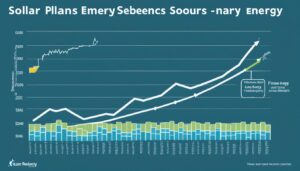
Are you considering installing solar panels to reduce costs and embrace renewable power in the United States? There’s good news! You may be eligible for solar energy grants and subsidies that can help make your transition to solar power more affordable. In this article, I will guide you through the steps of qualifying for these grants and subsidies, so you can take advantage of financial assistance and contribute to a sustainable future.
First, let’s understand what solar energy grants and subsidies are and how they work. These government incentives and financial assistance programs are designed to promote the adoption of solar power by providing support to individuals, businesses, and organizations. By installing solar panels, you can generate clean energy and reduce your dependence on traditional energy sources.
To qualify for these grants and subsidies, you need to meet certain eligibility requirements. These requirements can vary depending on the specific program and funding source. Typical criteria include income limits, property criteria, and the type of solar system you are installing. It is essential to review the guidelines of each grant and subsidy program to ensure you meet the necessary qualifications.
There are various types of solar energy grants and subsidies available at both the federal and state levels. Federal solar grants provide financial assistance for solar projects, while state solar grants offer funding opportunities that vary by location. Additionally, solar rebates and tax credits can help offset the cost of solar panel installation. Understanding the different types of grants and subsidies available can help you identify the best opportunities for your solar project.
Applying for solar energy grants and subsidies typically involves a formal application process. This process may require you to provide documentation such as proof of income, property ownership, and project details. It’s important to carefully review the application requirements and deadlines to ensure a successful submission. Seeking assistance from solar installation professionals or grant consultants can help streamline the application process and increase your chances of qualifying for financial assistance.
Qualifying for solar energy grants and subsidies is an excellent way to reduce the costs of installation and embrace renewable power. Take advantage of these opportunities to make your solar project more affordable and contribute to a sustainable future.
Key Takeaways:
- Solar energy grants and subsidies can help reduce the costs of installing solar panels and embrace renewable power.
- Eligibility requirements for these grants and subsidies include income limits, property criteria, and the type of solar system being installed.
- There are various types of grants and subsidies available at the federal and state levels, including solar rebates and tax credits.
- Applying for grants and subsidies involves a formal application process that may require documentation and careful review of requirements and deadlines.
- Seeking assistance from solar installation professionals or grant consultants can help streamline the application process.
Understanding Solar Energy Grants and Subsidies
Solar energy grants and subsidies play a vital role in promoting the adoption of solar power by offering government incentives and financial assistance programs. These initiatives aim to support individuals, businesses, and organizations in their efforts to install solar panels and generate clean energy. By understanding how these grants and subsidies work, you can determine your eligibility and maximize the benefits they provide.
Government incentives such as solar energy grants and subsidies can significantly reduce the financial burden of installing solar panels. They provide the necessary financial support to make renewable energy more accessible and affordable for everyone. Whether you are a homeowner, a small business owner, or an organization, these programs can help you overcome the initial costs and make the transition to clean energy.
Financial assistance is crucial for many individuals and businesses to embrace solar energy. Solar energy grants and subsidies can cover a significant portion of the installation costs, making it a more feasible option. These government programs often aim to increase the adoption of solar power, reduce reliance on fossil fuels, and promote sustainability.
One example of a solar energy grant program is the federal Investment Tax Credit (ITC), which offers a substantial tax credit to individuals and businesses that install solar energy systems. This program allows you to deduct a percentage of the installation costs from your taxes, reducing your overall expenses. State-level programs and incentives also exist to further encourage the adoption of solar power.
To better understand solar energy grants and subsidies, it’s crucial to explore the different types of financial support available. These may include cash grants, rebates, tax credits, low-interest loans, or performance-based incentives. Each program has its own eligibility requirements and benefits, so it’s essential to research and identify the options that best suit your needs.
Benefits of Solar Energy Grants and Subsidies:
- Financial assistance to reduce the upfront costs of installing solar panels
- Promotion of renewable energy sources and reduced reliance on fossil fuels
- Contribution to a cleaner environment and reduced greenhouse gas emissions
- Potential savings on energy bills through the generation of clean, sustainable energy
By taking advantage of solar energy grants and subsidies, you can reduce the financial barriers associated with adopting solar power. These incentives not only make solar energy more accessible and affordable but also contribute to a greener future. Whether you’re a homeowner looking to save on energy costs or a business aspiring to be more sustainable, explore the various government programs available to maximize the benefits of solar energy grants and subsidies.
Stay tuned for the next section to learn more about the eligibility requirements for solar energy grants and subsidies.
The image below illustrates the impact of solar energy grants and subsidies:
Eligibility Requirements for Solar Energy Grants and Subsidies
To qualify for solar energy grants and subsidies, there are certain eligibility requirements that you need to meet. These requirements can vary depending on the specific program and funding source. Some common eligibility criteria include income limits, property criteria, and the type of solar system you are installing. It’s important to review the guidelines of each grant and subsidy program to ensure you meet the necessary requirements.
One of the key eligibility requirements for solar energy grants and subsidies is the income limit. These programs often have income thresholds that determine whether you qualify for financial assistance. These limits are typically based on your household income and size.
Another factor that may impact your eligibility is the property criteria. Some grant and subsidy programs require the property where the solar system is installed to meet certain criteria. This could include factors such as property ownership, type of dwelling (residential or commercial), or the presence of any previous solar installations.
Additionally, the type of solar system you plan to install can also affect your eligibility for grants and subsidies. Some programs may have specific requirements regarding the size, type, or efficiency of the solar equipment in order to qualify for financial assistance.
Income Limits
Income limits are a crucial consideration when it comes to determining your eligibility for solar energy grants and subsidies. The specific income thresholds can vary depending on the program, but they are typically designed to target financial assistance to individuals and households with lower incomes.
For example, the Low-Income Home Energy Assistance Program (LIHEAP) offers financial assistance for energy-related expenses, including solar installation. To be eligible for LIHEAP, your household income must fall within the federal poverty guidelines, which are based on the number of individuals in your household.
Income limits are often adjusted annually to account for changes in the cost of living. It’s important to check the most up-to-date income limits for each program to ensure you meet the requirements.
Property Criteria
Property criteria can also play a role in determining your eligibility for solar energy grants and subsidies. These criteria can vary depending on the program and may include factors such as property ownership, type of property, and the presence of any existing solar installations.
For example, some grant programs may require you to own the property where the solar system will be installed. This ensures that the financial assistance is directed towards property owners who will benefit from the long-term energy savings.
Additionally, certain programs may have specific requirements for residential or commercial properties. This could mean that grants and subsidies are only available for certain types of properties, such as single-family homes or small businesses.
Type of Solar System
The type of solar system you plan to install can also impact your eligibility for grants and subsidies. Some programs have specific criteria regarding the size, type, or efficiency of the solar equipment in order to qualify for financial assistance.
For example, certain programs may prioritize funding for residential solar systems that meet certain energy efficiency standards. This encourages the adoption of more sustainable and efficient solar technologies.
It’s essential to carefully review the guidelines of each grant and subsidy program to determine if your proposed solar system meets the necessary requirements.
| Grant/Subsidy Program | Income Limits | Property Criteria | Type of Solar System Criteria |
|---|---|---|---|
| Program 1 | Based on federal poverty guidelines | Property ownership required | Minimum solar system size required |
| Program 2 | Income below X% of median income | Type of property (residential/commercial) | Energy efficiency standards |
| Program 3 | Income limits based on household size | Property ownership or long-term lease | Prioritize certain solar technologies |
Types of Solar Energy Grants and Subsidies
When it comes to financing your solar project, there are several types of grants and subsidies available at both the federal and state levels. These financial incentives can significantly reduce the cost of solar panel installation and make renewable energy more accessible.
Federal Solar Grants
One of the primary sources of funding for solar projects is through federal solar grants. These grants are provided by government agencies and organizations to support the growth of solar energy nationwide. They typically require an application process and have specific eligibility criteria.
“Federal solar grants offer a valuable opportunity for individuals, businesses, and organizations to receive financial assistance for their renewable energy projects.”
To increase your chances of qualifying for federal solar grants, it’s important to thoroughly review and understand the application requirements. Provide all necessary documentation and ensure that your project aligns with the objectives outlined by the grant program.
State Solar Grants
In addition to federal grants, many states also offer their own solar grant programs. These state-level grants provide funding opportunities that vary depending on your location. Each state has unique eligibility requirements, application processes, and funding amounts available.
“State solar grants present an excellent opportunity for individuals and businesses to leverage local financial assistance for their solar projects.”
Researching the specific state solar grant programs in your area is crucial to understanding the available funding options. By identifying the programs that align with your project goals, you can maximize your chances of securing state solar grants.
Solar Rebates
In addition to grants, solar rebates can also help offset the cost of solar panel installation. These rebates are typically offered by utility companies or other organizations and provide a direct financial incentive for installing solar systems.
“Solar rebates can significantly reduce the upfront costs of going solar, making it a more affordable option for many.”
When researching solar rebates, consider factors such as rebate amounts, eligibility requirements, and application processes. Understanding the available rebates in your area can help you take advantage of these cost-saving opportunities.
Tax Credits
Another form of financial assistance for solar projects comes in the form of tax credits. These credits allow individuals and businesses to reduce their tax liability based on the cost of their solar installation. The federal government and several states offer various tax credits for solar energy.
“Tax credits provide a long-term financial benefit for solar adopters, reducing the overall cost of their solar project in the form of tax savings.”
Before claiming solar tax credits, consult a tax professional to understand the eligibility criteria and requirements. Taking advantage of these tax incentives can result in substantial savings and make your solar project more affordable.

| Grant Type | Description |
|---|---|
| Federal Solar Grants | Financial assistance provided by government agencies and organizations to promote solar energy projects. |
| State Solar Grants | Funding opportunities offered by states to support solar installations at the local level. |
| Solar Rebates | Direct financial incentives provided by utility companies or organizations to offset the cost of solar panel installation. |
| Tax Credits | Reductions in tax liability based on the cost of a solar installation, offered by the federal government and specific states. |
Applying for Solar Energy Grants and Subsidies
Applying for solar energy grants and subsidies involves a formal application process that requires careful attention to documentation and deadlines. To increase your chances of a successful submission and streamline the process, it’s important to understand the grant application process and subsidy application process.
Grant Application Process
The grant application process for solar energy projects typically involves the following steps:
- Research Grants: Begin by researching available grants that align with your project. Consider federal and state programs that offer financial assistance for solar installations.
- Gather Documentation: Collect all necessary documentation, including proof of income, property ownership, and project details. Each grant may require specific documentation, so be sure to review the requirements thoroughly.
- Follow Application Guidelines: Carefully read and follow the application guidelines provided by the grant program. Pay attention to formatting requirements, submission deadlines, and any additional information requested.
- Complete the Application: Fill out the grant application form accurately and provide all required information. Be concise and informative in your responses.
- Submit and Review: Submit your completed application by the specified deadline and keep a copy for your records. Read through the application one final time to ensure all information is accurate and complete.
Subsidy Application Process
The subsidy application process may differ from grants and generally involves the following steps:
- Identify Subsidy Programs: Identify the subsidy programs available in your area and determine which ones apply to your solar energy project.
- Check Eligibility: Review the eligibility requirements of each subsidy program to ensure your project meets the necessary criteria.
- Prepare Documentation: Gather all required documentation, such as proof of income, property ownership, and project details.
- Submit Application: Complete the subsidy application form accurately and submit it within the specified timeframe. Be sure to include all necessary documentation as per the program’s guidelines.
- Follow Up: After submitting your application, follow up with the subsidy program to confirm receipt and inquire about the review process timeline.
Remember, meeting the documentation requirements and submitting your application before the deadlines are crucial factors for successful grant and subsidy applications.

Conclusion
Qualifying for solar energy grants and subsidies is a vital step towards reducing the costs of installation and embracing renewable power. By understanding the eligibility requirements, types of grants and subsidies available, and the application process, you can significantly increase your chances of receiving the financial assistance you need. Seize these opportunities to make your solar project more affordable and contribute to a sustainable future.
Investing in solar energy can be a significant financial commitment, but with the help of grants and subsidies, you can make it more attainable. These financial incentives are designed to support individuals, businesses, and organizations in their transition to cleaner and more sustainable energy sources.
When applying for grants or subsidies, it’s crucial to carefully review the guidelines and requirements of each program. Prepare all the necessary documentation and meet the specified deadlines. Seeking assistance from solar installation professionals or grant consultants can also simplify the application process and increase your chances of success.
By accessing financial assistance through grants and subsidies, you not only reduce the upfront costs of installing solar panels but also contribute to the greater goal of achieving a greener and more sustainable future. Take advantage of these opportunities today and join the growing community of individuals and organizations embracing renewable power.
FAQ
What are solar energy grants and subsidies?
Solar energy grants and subsidies are government incentives and financial assistance programs that promote the adoption of solar power. They provide financial support to individuals, businesses, and organizations looking to install solar panels and generate clean energy.
How can I qualify for solar energy grants and subsidies?
To qualify for solar energy grants and subsidies, you need to meet certain eligibility requirements. These requirements can include income limits, property criteria, and the type of solar system you are installing. It’s important to review the guidelines of each program to ensure you meet the necessary requirements.
What types of solar energy grants and subsidies are available?
There are various types of solar energy grants and subsidies available at both the federal and state levels. Federal solar grants provide financial assistance for solar projects, while state solar grants offer funding opportunities that vary by location. Additionally, solar rebates and tax credits can help offset the cost of solar panel installation.
What is the application process for solar energy grants and subsidies?
Applying for solar energy grants and subsidies involves a formal application process. You may need to provide documentation such as proof of income, property ownership, and project details. It’s important to carefully review the application requirements and deadlines to ensure a successful submission. Seeking assistance from solar installation professionals or grant consultants can help streamline the process.








